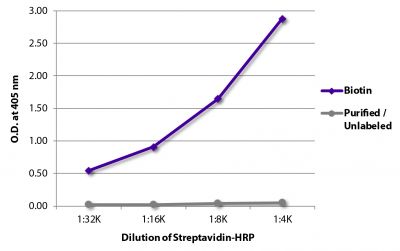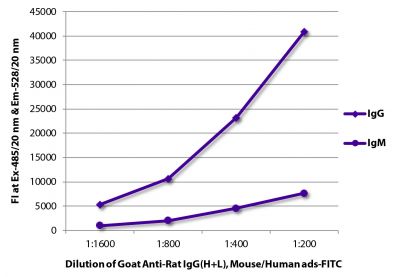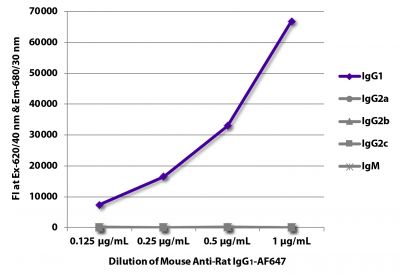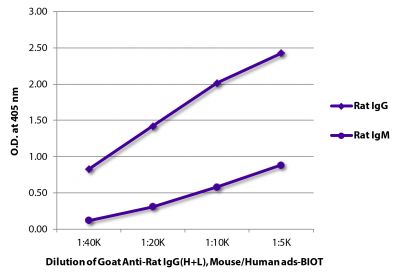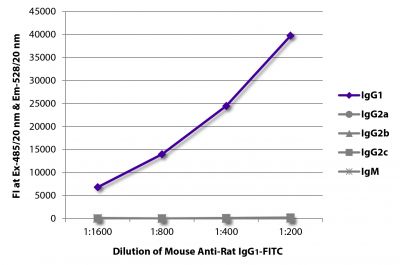Rat Anti-Mouse IL-17A-LE/AF (TC11-18H10)
Cat. No.:
10215-14
Low Endotoxin/Azide Free Anti-Mouse IL-17A antibody for use in flow cytometry, ELISA, ELISpot, and neutralization assays.
$308.00
| Clone | TC11-18H10 |
|---|---|
| Isotype | Rat IgG1κ |
| Isotype Control | Rat IgG1-LE/AF (KLH/G1-2-2) |
| Specificity | Mouse IL-17A |
| Alternative Names | Interleukin-17A, cytotoxic T lymphocyte-associated antigen 8, CTLA-8 |
| Immunogen | E. coli-expressed mouse IL-17 |
| Conjugate | LE/AF (Low Endotoxin/Azide Free) |
| Buffer Formulation | Phosphate buffered saline, pH 7.4 |
| Clonality | Monoclonal |
| Concentration | 0.5 mg/mL |
| Volume | 1.0 mL |
| Recommended Storage | 2-8°C; Handle under aseptic conditions |
| Applications |
ELISA-Capture – Quality tested 1 ELISpot-Capture – Reported in literature 2,3 Flow Cytometry – Reported in literature 4,5 Neutralization – Reported in literature 6-12 Note – May be paired with the biotinylated clone TC11-8H4 (SB Cat. No. 10214-08) in a sandwich ELISA |
| RRID Number | AB_2794260 |
| Gene ID |
16171 (Mouse) |
| Gene ID Symbol |
Il17a (Mouse) |
| Gene ID Aliases | Ctla-8; Ctla8; IL-17; IL-17A; Il17 |
| UniProt ID |
Q62386 (Mouse) |
| UniProt Name |
IL17_MOUSE (Mouse) |
Documentation
Certificate of Analysis Lookup
Enter the Catalog Number and Lot Number for the Certificate of Analysis you wish to view
- 1. Amsen D, de Visser KE, Town T. Approaches to determine expression of inflammatory cytokines. Methods Mol Biol. 2009;511:107-42. (ELISA-Capture)
- 2. Nekrasova T, Shive C, Gao Y, Kawamura K, Guardia R, Landreth G, et al. ERK1-deficient mice show normal T cell effector function and are highly susceptible to experimental autoimmune encephalomyelitis. J Immunol. 2005;175:2374-80. (ELISPOT-Capture)
- 3. Faust SM, Lu G, Marini BL, Zou W, Gordon D, Iwakura Y, et al. Role of T cell TGFβ signaling and IL-17 in allograft acceptance and fibrosis associated with chronic rejection. J Immunol. 2009;183:7297-306. (ELISPOT-Capture)
- 4. Hamada H, Garcia-Hernandez Mde L, Reome JB, Misra SK, Strutt TM, McKinstry KK, et al. Tc17, a unique subset of CD8 T cells that can protect against lethal influenza challenge. J Immunol. 2009;182:3469-81. (FC)
- 5. Le Huu D, Matsushita T, Jin G, Hamaguchi Y, Hasegawa M, Takehara K, et al. Donor-derived regulatory B cells are important for suppression of murine sclerodermatous chronic graft-versus-host disease. Blood. 2013;121:3274-83. (FC)
- 6. He D, Wu L, Kim HK, Li H, Elmets CA, Xu H. CD8+ IL-17-producing T cells are important in effector functions for the elicitation of contact hypersensitivity responses. J Immunol. 2006;177:6852-8. (Neut)
- 7. Yusuf N, Nasti TH, Long JA, Naseemuddin M, Lucas AP, Xu H, et al. Protective role of Toll-like receptor 4 during the initiation stage of cutaneous chemical carcinogenesis. Cancer Res. 2008;68:615-22. (Neut)
- 8. He D, Wu L, Kim HK, Li H, Elmets CA, Xu H. IL-17 and IFN-γ mediate the elicitation of contact hypersensitivity responses by different mechanisms and both are required for optimal responses. J Immunol. 2009;183:1463-70. (Neut)
- 9. Xiao M, Wang C, Zhang J, Li Z, Zhao X, Qin Z. IFNγ promotes papilloma development by up-regulating Th17-associated inflammation. Cancer Res. 2009;69:2010-7. (Neut)
- 10. He D, Li H, Yusuf N, Elmets CA, Li J, Mountz JD, et al. IL-17 promotes tumor development through the induction of tumor promoting microenvironments at tumor sites and myeloid-derived suppressor cells. J Immunol. 2010;184:2281-8. (Neut)
- 11. Kish DD, Volokh N, Baldwin WM 3rd, Fairchild RL. Hapten application to the skin induces an inflammatory program directing hapten-primed effector CD8 T cell interaction with hapten-presenting endothelial cells. J Immunol. 2011;186:2117-26. (Neut)
- 12. Karmakar S, Bhaumik SK, Paul J, De T. TLR4 and NKT cell synergy in immunotherapy against visceral leishmaniasis. PLoS Pathog. 2012;8(4):e1002646. (Neut)
See All References



